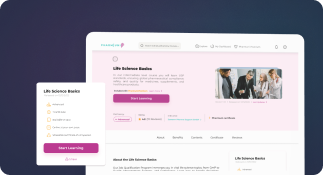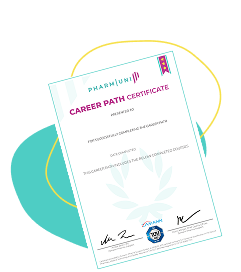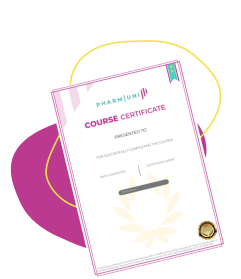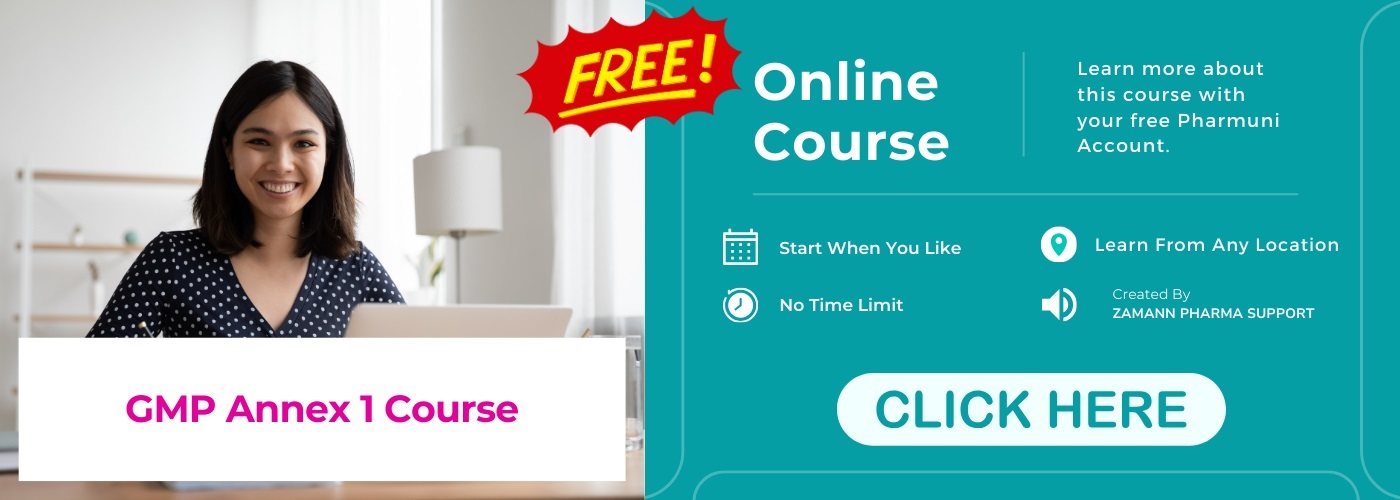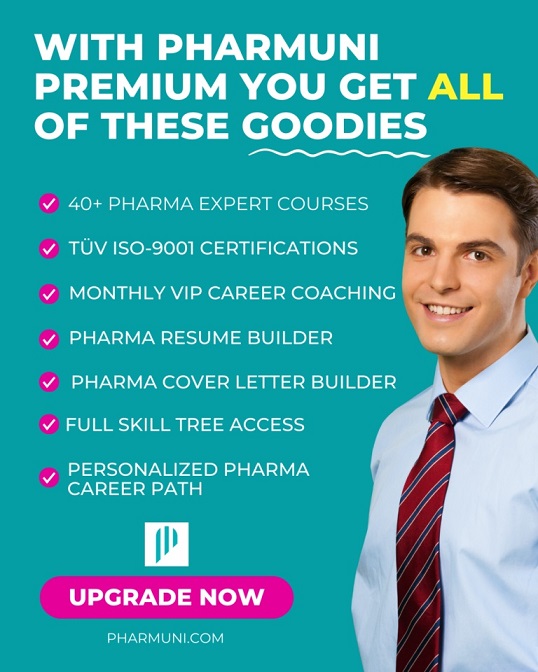The revised EU GMP Annex 1 presents a significant transformation in sterile pharmaceutical manufacturing. With its extensive 2022 overhaul, Annex 1 now demands the adoption of a formalized risk-based approach, robust contamination control strategies, and meticulously documented aseptic process validations.
In today’s globalized supply chain, regulatory preparedness directly impacts market access and patient safety. Facilities manufacturing sterile products must demonstrate process control, data integrity, and personnel competency at every stage.
This article provides a comprehensive audit-preparedness framework aligned with EU GMP Annex 1 principles.

Conceptual Foundation and Regulatory Significance of Annex 1
Annex 1, a cornerstone of the EU’s Good Manufacturing Practice (GMP) regulations, governs the sterile manufacturing environment. It outlines minimum standards for aseptic processing, facility engineering, environmental monitoring, equipment qualification, and operator conduct. These stipulations are foundational to the integrity and reproducibility of sterile drug production.
The 2022 revision represents a harmonized interpretation of modern GMP practices, addressing historical ambiguities while aligning with technological advances.Notably, it introduces the Contamination Control Strategy (CCS) as a centralized framework for managing risk, enforcing environmental boundaries, and validating process reliability.
The directive emphasizes personnel competency, gowning discipline, data integrity, and integration of automation where feasible.
As regulators increasingly focus on process understanding and real-time monitoring, organizations must integrate CCS thinking across all production and QA functions.
The new Annex 1 transforms sterile manufacturing into a dynamic, evidence-based discipline.
Recommendation: Leverage our free GMP Annex 1 course as a training prerequisite for quality teams, engineers, and cleanroom operators.
Sign up for Introduction to GMP Annex 1 Course
Key Categories in Annex 1 Audit
Sterile Manufacturing & Aseptic Processing
First, organizations design sterile workflows that block every contamination route. Next, teams schedule validated Aseptic Process Simulations during routine and stress modes. Moreover, they challenge lines with maximum personnel and equipment loads. Consequently, data confirm that dynamic conditions stay within microbiological limits.
Then engineers set risk profiles for each product-pathogen pairing. Therefore, they choose terminal sterilization or aseptic processing accordingly. Thus, they detect deviations early and launch corrective action. Finally, continuous verification keeps processes audit-ready.
First, cleanroom architects assign Grades A to D for every zone. Then, they calibrate airflow to maintain positive pressure differentials. Moreover, particle and microbial counters track real-time environmental health.
Consequently, alerts trigger sanitation when counts approach action limits. Meanwhile, analysts trend hourly readings to reveal performance drifts. Therefore, teams adjust cleaning schedules as deviations escalate. Additionally, deviation reports link anomalies to root causes and corrective tasks. Next, quality managers review aggregated metrics during monthly CCS meetings.

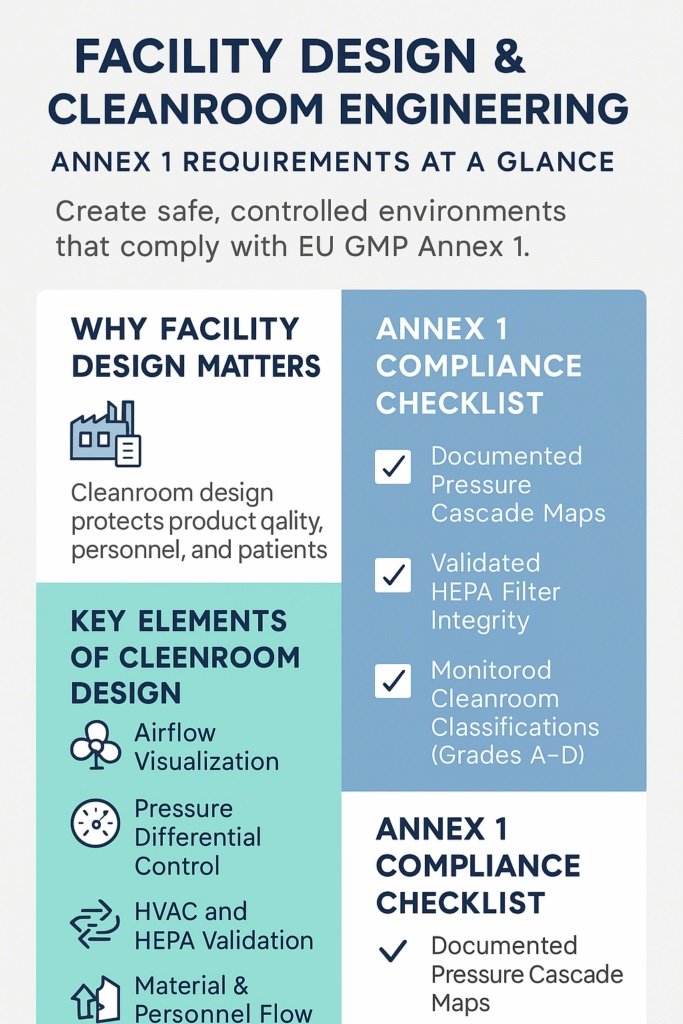
Facility Design & Cleanroom Engineering
First, planners sketch pathways that never intersect. Then, they assign separate doors for people and pallets. Moreover, colored floor markings guide everyone effortlessly. Next, airlocks control entries with strict interlocking doors. Consequently, pressure gradients always push contaminants outward.
Meanwhile, dedicated gowning rooms sit before critical zones. Additionally, lockers segregate street clothes from sterile garments. Afterward, mirrors help operators inspect gown integrity. Furthermore, automatic hand washers reduce microbial load quickly. Finally, supervisors walk the flow daily to verify compliance.
First, engineers balance HVAC flows with calibrated sensors. Next, they record differential pressures across every doorway. Moreover, dashboards flash when gradients slip marginally. Then, technicians test HEPA filters for tight seal integrity. Meanwhile, smoke studies visualize airflow around equipment. Consequently, teams identify dead zones needing tweaks. Additionally, high-speed cameras capture turbulent plumes during operations.
Afterward, analysts embed annotated videos in validation dossiers. Furthermore, monthly reports chart pressure cascades against Annex requirements. Finally, quality leaders present metrics to auditors without hesitation.
Critical Domains within the Annex 1 Audit Checklist
Sterile Manufacturing & Aseptic Processing
Mastering sterile technique mitigates microbial ingress during the most vulnerable operations. Annex 1 mandates documented justification for every aseptic intervention, backed by routine media fills. Continuous process verification ensures each batch maintains the required Sterility Assurance Level.
Facility Design & Cleanroom Engineering
Architectural layout governs airflow paths, pressure cascades, and surface decontaminability. Engineers must correlate each physical barrier with the facility’s contamination control strategy. Scheduled requalification confirms the envelope continues to meet Annex 1 performance criteria.
Personnel Training & Qualification
Competency programs must integrate theoretical microbiology with hands on gowning drills. Requalification intervals are risk based and supported by behavioral monitoring records. Data from glove prints and media contact plates feed directly into individual performance dashboards.
Equipment & Technology Infrastructure
Robust equipment qualification (IQ/OQ/PQ) underpins process reproducibility. Automation—especially isolators and robotics—reduces human error and bioburden. Remote sensor arrays provide real time alerts for any deviation from validated setpoints.
Risk Management & Quality Assurance
Quality Risk Management (QRM) tools prioritize resources toward high impact hazards. Annex 1 expects cross functional teams to own risk registers and review them quarterly. KPIs link directly to executive quality objectives, driving a culture of accountability.
Cleaning & Disinfection Protocols
Rotation of sporicidal agents prevents adaptive microbial resistance. Cleaning validation studies measure residue levels and material compatibility. Digital checklists timestamp each step, providing irrefutable proof of execution.
Regulatory Intelligence & Global Compliance
Continuous horizon scanning anticipates changes in EMA, FDA, and PIC/S guidance. Cross mapping exercises align site SOPs with multiple jurisdictions. Annual mock inspections validate readiness against the strictest applicable standard.
Operationalizing Compliance
Process Validation and Control Strategy
First, engineers choose filters rated for product viscosity and bioburden. Next, technicians perform bubble point tests before every processing batch. Moreover, they log pressure values to confirm integrity stays consistent. Additionally, sensors record pressure across filter membranes. Then, operators run media fills that mirror normal flow rates and timings. Consequently, they capture worst-case interventions, pauses, and equipment touches. Finally, quality staff retest filters after processing to verify unchanged barrier strength. Thus, data prove continuous sterile filtration control.
First, analysts calculate Sterility Assurance Levels for every filtration step. Moreover, they target probabilities not exceeding one contaminant per million units. Then, validation protocols challenge hold times using temperature and pressure extremes. Meanwhile, teams schedule strict cleaning cycles that eliminate residue before biofilm forms. Additionally, they monitor piping dead-legs where microbes may creep inward. Consequently, risk assessments update whenever data show trending deviations upward. Moreover, they verify chemical compatibility after exposure periods. Finally, auditors review consolidated reports to confirm processes meet Annex expectations.
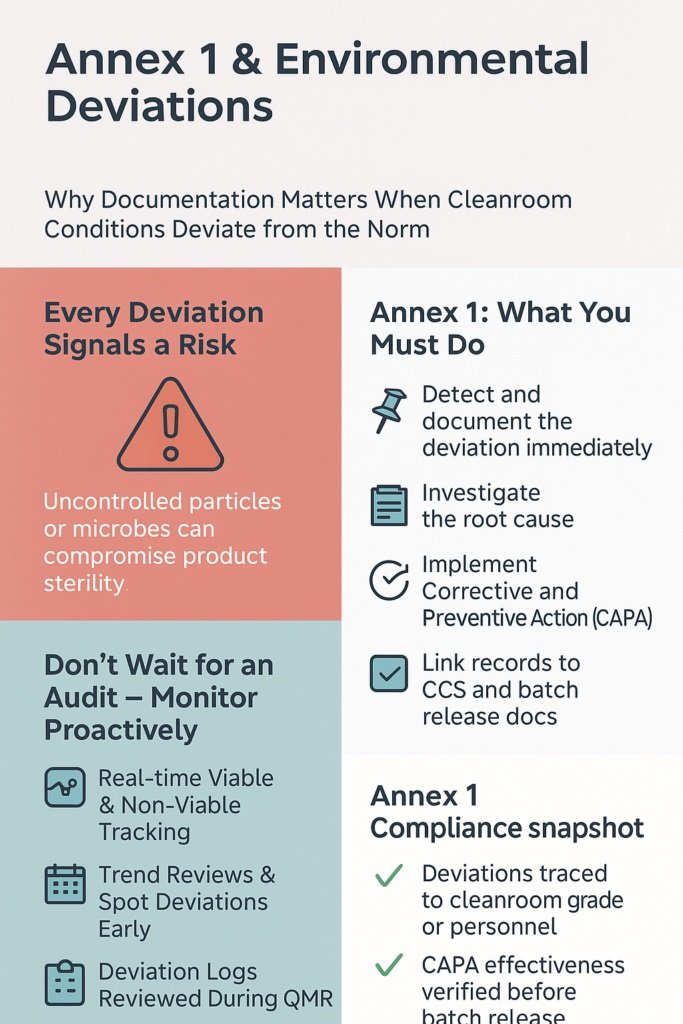
Environmental Monitoring Systems
First, Annex 1 requires round-the-clock monitoring in all critical cleanroom areas. Therefore, teams install viable and non-viable particle counters near key process zones.
Moreover, sensors collect data continuously during production shifts. Then, systems send alerts when readings exceed cleanroom limits. Consequently, operators respond fast to prevent contamination events. In addition, engineers regularly calibrate the instruments to ensure accurate results.
Next, quality teams check readings daily for any unexpected changes. Finally, all readings feed into validated monitoring software for traceability.
First, quality leaders define alert and action levels using past process performance. Moreover, they adjust limits based on seasonal or equipment changes. Then, statisticians design sampling plans that cover high-risk operations. Additionally, they explain how sample size supports reliable detection.
Next, teams compare new trends with historical baselines monthly. Consequently, any shift triggers updates to the Contamination Control Strategy (CCS).
Furthermore, they present findings during the Quality Management Review (QMR). Therefore, leaders decide actions using real data. Finally, this process strengthens control and audit readiness.
Essential Documentation for Annex 1 Compliance
CCS master document
The CCS aggregates all facility wide contamination risks into a single narrative. Each hazard is scored for probability, severity, and detectability. Governing councils review and endorse the CCS at least once per year.
Cleanroom classification reports
Particle counts and pressure profiles substantiate the assigned room grades. Engineers must link every airflow reading to calibration certificates. Trending reports reveal whether seasonal shifts erode system performance.
Aseptic simulation protocols
Media fill designs mirror worst case line interventions and hold times. Investigators analyze each container for turbidity under controlled lighting. Failures trigger root cause investigations and halt production until corrective actions verify effectiveness
Autoclave and sterilizer validation
Thermocouple mapping demonstrates temperature uniformity within the chamber. Biological indicator reductions confirm lethality in hardest to reach spots. Cycle parameters lock into PLCs with password protected recipe management.
Behavioral monitoring of operators in Grade A/B
CCTV or in line sensors track hand motions, dwell times, and movement speed. Deviations surface during weekly quality huddles. Metrics feed into individual performance reviews and incentive programs.
Strategic Review Intervals for the Contamination Control Strategy
CCS must remain a living document. Update your strategy:
• After any deviation, media fill failure, or EM excursion
• When commissioning new equipment or facility areas
• Following audit observations or quality investigations
• Annually as part of the Quality Management System review
The CCS should integrate learnings from behavioral audits, maintenance trends, and supplier quality metrics. Regulatory expectations emphasize closed-loop improvement, not static documentation.
👉 Download audit-ready templates from Pharmuni.com.
Conclusion: Annex 1 Readiness as a Competitive Advantage
Compliance with EU GMP Annex 1 is no longer a checkbox—it defines competitive viability in a post-pandemic world. A mature Annex 1 strategy encompasses more than SOPs; it integrates data science, team culture, and risk-based decision-making. Companies that invest in CCS implementation, automation, and real-time monitoring position themselves as industry leaders.
Act now to future-proof your GMP infrastructure: Introduction to GMP Annex 1
✅ Browse Pharmuni’s full library of regulatory courses: Pharmuni.com
References

Ershad Moradi
Ershad Moradi, a Content Marketing Specialist at Zamann Pharma Support, brings 6 years of experience in the pharmaceutical industry. Specializing in pharmaceutical and medical technologies, Ershad is currently focused on expanding his knowledge in marketing and improving communication in the field. Outside of work, Ershad enjoys reading and attending industry related networks to stay up-to-date on the latest advancements. With a passion for continuous learning and growth, Ershad is always looking for new opportunities to enhance his skills and contribute to pharmaceutical industry. Connect with Ershad on Facebook for more information.

Dechallenge in Pharmacovigilance: Meaning, ADR Causality, and ICSR Documentation
Dechallenge is what you observe after stopping a suspected medicine. If symptoms improve, you gain supportive evidence for causality assessment. However, improvement alone does not prove the drug caused the event. So, document drug action, dates, and outcomes clearly. Then compare with rechallenge, which can strengthen causality when safe and justified.

Rechallenge in Pharmacovigilance: Meaning, Positive Rechallenge, and ICSR Reporting
Rechallenge in pharmacovigilance helps you assess causality when symptoms recur after re-exposure. This guide explains meaning, where to record outcomes in an ICSR, and how to judge validity. It also shows why clear timelines and dose details protect patients. Strong documentation also builds your Pharmacovigilance Career Path through better case quality.
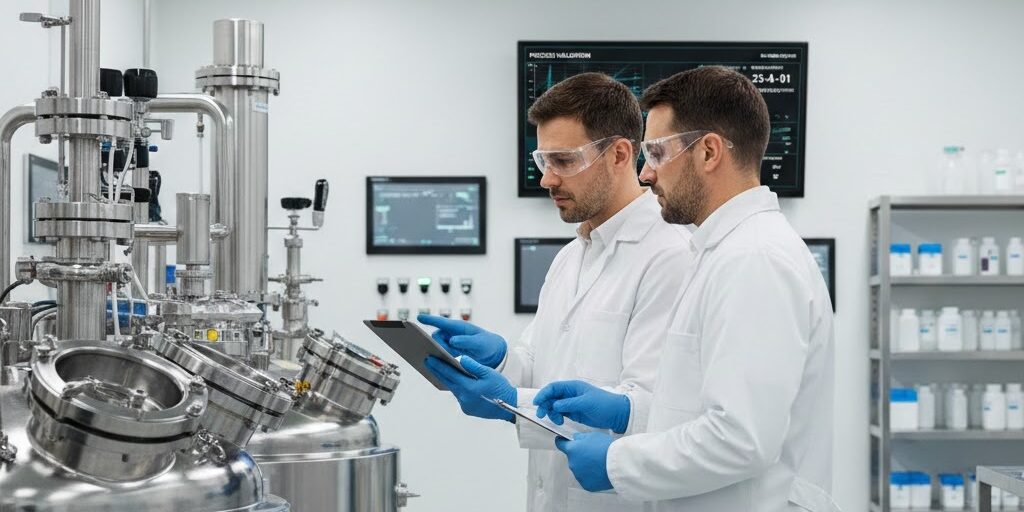
Concurrent Validation in Pharma 2026 Guide: Meaning, Acceptance, and Execution Steps
Concurrent validation in pharma lets you verify a process while you manufacture saleable batches. Use it only when you face real supply urgency and you can’t wait for prospective validation. Build a risk-based protocol, tighten controls, and document every decision for inspection readiness.
